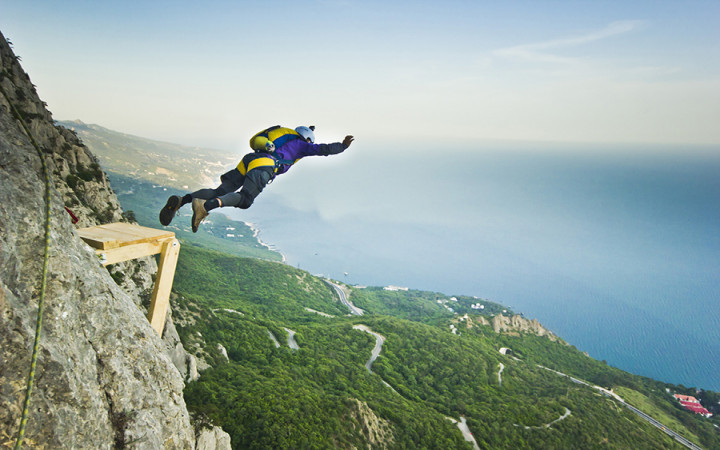Today’s Wonder of the Day was inspired by Kloe from Frankfort, KY. Kloe Wonders, “What makes a person jump?” Thanks for WONDERing with us, Kloe!
What's the most thrilling experience you can think of? For some people, it's the thought of boarding an airplane, flying high into the sky, flinging themselves out of the plane, and hurtling toward the ground with only a parachute to prevent certain death.
Is skydiving one of the items on your bucket list? Or would you rather keep your feet planted firmly on the ground? Although it might seem like skydiving would be enough of an adrenaline rush for anyone, there were actually people who searched for — and found! — an even bigger thrill.
Way back in 1978, filmmaker Carl Boenish, Jr., along with his wife, Jean, and friends Phil Smith and Phil Mayfield, climbed to the top of El Capitan in Yosemite National Park. They then ran to the edge and flung themselves off the top, releasing a ram-air parachute a few seconds later to slow their descent.
In the process, they invented a new sport called BASE jumping, which is basically like skydiving without the airplane. BASE jumping consists of parachuting from fixed objects. In fact, the acronym BASE comes from the four main categories of objects thrill-seekers jump from: Buildings, Antennas, Spans (bridges), and Earth (cliffs, for example).
BASE jumping is considered an extreme sport, because it is extremely dangerous. To date, over 300 BASE jumpers have died as a result of accidents that occurred during BASE jump attempts. Regular skydiving is much safer than BASE jumping.
BASE jumpers must overcome two major obstacles that skydivers don't face: low altitude and proximity to the object they're jumping from. Skydivers usually deploy their parachutes at about 2,000 feet in elevation. BASE jumpers, however, often jump from objects well under 2,000 feet tall.
This means BASE jumpers must open their parachutes very quickly after they jump, and there isn't much time to deal with any problems that might arise. Fortunately, BASE jumpers can use modern, rectangular ram-air parachutes that give them greater control over their descent. These custom parachutes can cost $1,500 or more.
In the early years of BASE jumping, fatalities were fairly consistent at about five per year. That number began to rise in the early 2000s, however, with the introduction of a new piece of specialty gear: the wingsuit.
Developed in the mid-1990s by French skydiver and BASE jumper Patrick de Gayardon, the wingsuit features extra material that captures air and adds surface area to the body. A wingsuit allows a jumper to glide through the air a bit like a flying squirrel.
When used during BASE jumping, wingsuits allow jumpers to engage in "proximity flying," which means flying close to objects, like trees, buildings, cliffs, etc. Jumpers wearing wingsuits can approach speeds of 140 miles per hour before launching their parachutes to make a safe landing.
Proximity flying with wingsuits has added an extra layer of extreme danger to the already-dangerous sport of BASE jumping. Typically, BASE jumpers will begin by becoming expert skydivers before moving on the BASE jumping.
After becoming an expert BASE jumper, they will then go back to skydiving to learn how to glide in a wingsuit while skydiving. Only after mastering the wingsuit in the skydiving context should a jumper then attempt proximity flying during a BASE jump.
Unfortunately, too many people are taking shortcuts. Instead of putting in the hundreds of hours and thousands of dollars to become an expert slowly, they gain just a bit of experience and then try to tackle proximity flying during a BASE jump.
The result has been disastrous. Of the more than 300 people who have died during BASE jumps, more than 260 of those have occurred since 2000 and the overwhelming majority of those fatalities have been attributed to wingsuits.




